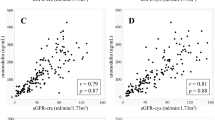Abstract
In 122 patients with the haemolytic uraemic syndrome (HUS), serum proteins were analysed in the acute phase of the disease (n = 122) and 6 weeks (n = 57) and 6 months (n = 84) later. Total serum protein levels were significantly lower on admission than 6 weeks and 6 months later (P < 0.0001). The same was true for median values of serum albumin (P < 0.0001), α2-globulins (P < 0.0001) and γ-globulins (P < 0.001). There was no difference in β-globulins, whereas the α1-globulins were significantly higher in the acute phase (P < 0.0001). There was a significant positive correlation between age and total protein and γ-globulin levels. Serum total protein and albumin levels displayed a significant positive correlation with serum sodium levels and a significant negative correlation with urinary protein excretion. Patients with oligoanuria had significantly lower serum albumin and significantly higher α1-globulin levels than those with preserved urine production. Marked differences were observed between patients with (D+) and patients without (D−) prodromal diarrhoea. In D(−) HUS, only albumin and total protein levels were lower on admission, but to a lesser degree than in D(+) HUS. Serum at-globulin levels were significantly higher and (α2-globulin levels significantly lower in D(+) HUS than D(−) HUS. In the D(+) subgroup of patients, by far the largest, there was a significant positive correlation between serum albumin and total protein on the one hand and the duration of the prodrome on the other. Patients with bloody stools had significantly lower serum albumin and total protein levels than those without. Faecal al-antitrypsin concentration measured in 12 HUS patients on admission was found to be significantly increased compared with age-matched controls. This study confirms the existence of hypoproteinaemia in childhood HUS and indicates that intestinal protein loss is an important, albeit not the only, physiopathological mechanism.
Similar content being viewed by others
References
Berman W (1972) The hemolytic uremic syndrome: initial clinical presentation mimicking ulcerative colitis. J Pediatr 81: 275–278
Serebruany VL, Christenson MJ, Pescetti J, McLean RH (1993) Hypoproteinemia in the hemolytic uremic syndrome of childhood. Pediatr Nephrol 7: 72–73
Wilson CM, McGilligan K, Thomas DW (1988) Determination of fecal α1-antitrypsin concentration by radial immunodiffusion: two systems compared. Clin Chem 34: 372–376
Author information
Authors and Affiliations
Rights and permissions
About this article
Cite this article
Goos, G., Declercq, P. & Proesmans, W. Serum proteins in the haemolytic uraemic syndrome. Pediatr Nephrol 9, 292–294 (1995). https://doi.org/10.1007/BF02254186
Received:
Accepted:
Issue Date:
DOI: https://doi.org/10.1007/BF02254186




